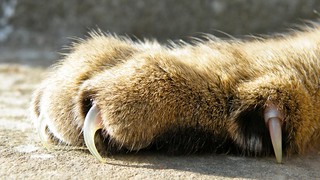I must admit, at one point in time, the only thing I knew about CG’s claws was how sharp they could be. But a cat’s claws are so much more than that. Other than understanding why cats have claws and how they use them, you may also want to brush up on other cat claw facts.

Photo courtesy barockschloss
Here are eight of them – some may be a review and some may be new to you. Either way, enjoy!
1. All cats have (or are at least are born with) claws on their front and rear paws. Most cats have five clawed digits on their front paws and four or five clawed digits on their rear paws. Some cats may have more clawed digits as a result of a mutation called polydactylism.
2. The fifth front clawed digit is proximal and is called the “dewclaw.” This thumb-like digit provides better grip and traction while playing or climbing.
3. The claws on the front paws are usually sharper than the ones on the hind feet.
4. A cat’s claws are curved, which helps them to hold onto prey. The curved claw also comes in handy when they’re climbing. Unfortunately, the curved design can also be problematic if the claws get tangled. This can cause injury to the cat if he can’t free himself.
5. Cats have retractable claws. Normally when the cat and his paws are relaxed, the claws are retracted, sheathed with the skin and fun around the toe pads. This helps keep the nails sharp since it cuts back on the wear from contact with the ground and other surfaces. It also allows a cat to walk silently, which is especially helpful when stalking prey.

Photo courtesy ajbunsby
6. A cat can voluntarily extend his claws on one or more paws. You can also make a cat extend his claw by carefully pressing down on the top and bottom of the toe at the same time. This will extend the claw, and it’s especially helpful when clipping your cat’s nails. Not sure if you should clip your CH cat’s claws? Read this.
7. The cat’s claws may be used for scratching an itch, hunting, self-defense, climbing, kneading, and for extra traction. You can learn more about why cats have claws and how you can use them here.
8. Like human fingernails, claws grow throughout a cat’s life. Consequently, they need some attention and maintenance. Most cats take care of this while using their teeth to pull at the rear claw sheaths, which reveals new, sharp claws underneath. For the front claws, they generally scratch on something, or hook their claws into a material to pull the old sheaths off. Click here for more information on scratching posts.
